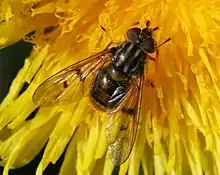Ferdinandea cuprea
Ferdinandea cuprea is a European species of hoverfly notable for its brassy abdomen. The larvae have been found in sap from trunk damage on oak and ash.[1]
| Ferdinandea cuprea | |
|---|---|
 | |
| female | |
| Scientific classification | |
| Kingdom: | |
| Phylum: | |
| Class: | |
| Order: | |
| Family: | |
| Genus: | |
| Species: | F. cuprea |
| Binomial name | |
| Ferdinandea cuprea | |
Description
External images
For terms see Morphology of Diptera
Wing length 7·25-11·25 mm. Thorax dorsum black with grey dust, with longitudinal black stripes strong black. Abdomen greenish with dull bands connecting to hind margin. Dark marks on the wings. Arista black. Male genitalia figured by Coe (1953).Larva illustrated by Hartley (1961) and Rotheray (1993) [2] and in colour by Rotheray (1993) [3] See references
[4]
[5]
[6]
[7]
Distribution
Palaearctic Fennoscandia South to southern Spain and the Mediterranean basin to Turkey. Ireland East through Central Europe and North Europe to the Pacific coast of Siberia and Japan.[8] [9]
Biology
Habitat:Populus-Salix, Carpinus-Quercus woodlands, Quercus pubescens and Quercus pyrenaica forest and Betula forest. Usually on the trunks of standing, live trees, or on the cut ends of stacked logs, in glades, or at the edge of clearings and along tracks or at sap runs.[10] Flowers visited include Convolvulus, Crataegus, Hieracium, Leontodon, Lonicera, Mentha, Oenothera, Prunus cerasus, Ranunculus, Rosa, Rubus fruticosus, Sonchus, Taraxacum, Ulmus.[11] The flight period is April to September (North Europe). The larvae have been found in wet, decomposing tree roots of Quercus and in the tree humus trunk cavities of Quercus as well as at sap runs. They may be both saprophages and detritivores.
References
- Stubbs, Alan E.; Falk, Steven J. (1983). British Hoverflies: An Illustrated Identification Guide. British Entomological & Natural History Society. p. 266, xv pp. ISBN 0-9502891-9-1.
- Hartley, J.C. (1961) A taxonomic account of the larvae of some British Syrphidae. Proc.zool.Soc.Lond.,136: 505-573.
- Rotheray G., 1993 Colour Guide to Hoverfly Larvae Diptera, Syrphidae in Britain and Europe Dipterists Forum pdf
- Van Veen, M. (2004) Hoverflies of Northwest Europe: identification keys to the Syrphidae. 256pp. KNNV Publishing, Utrecht.addendum
- Van der Goot, V.S. (1981) De zweefvliegen van Noordwest - Europa en Europees Rusland, in het bijzonder van de Benelux. KNNV, Uitgave no.32: 275pp. Amsterdam.
- Bei-Bienko, G.Y. & Steyskal, G.C. (1988) Keys to the Insects of the European Part of the USSR, Volume V: Diptera and Siphonaptera, Part I. Amerind Publishing Co., New Delhi. ISBN 81-205-0080-6.
- Coe, R.L. (1953) Diptera: Syrphidae. Handbks.ident.Br.insects, 10(1): 1-98. R.ent.Soc.London. pdf
- Fauna Europaea
- Peck, L.V. (1988) Syrphidae. In: Soos, A. & Papp, L. (eds.) Catalogue of Palaearctic Diptera, 8: 11-230. Akad.Kiado, Budapest.
- Speight, M.C.D. (2011). "Species accounts of European Syrphidae (Diptera)" (PDF). Syrph the Net, the database of European Syrphidae. 65: 285pp.
- de Buck, N. (1990) Bloembezoek en bestuivingsecologie van Zweefvliegen (Diptera, Syrphidae) in het bijzonder voor België. Doc.Trav. IRSNB, no.60, 1-167.